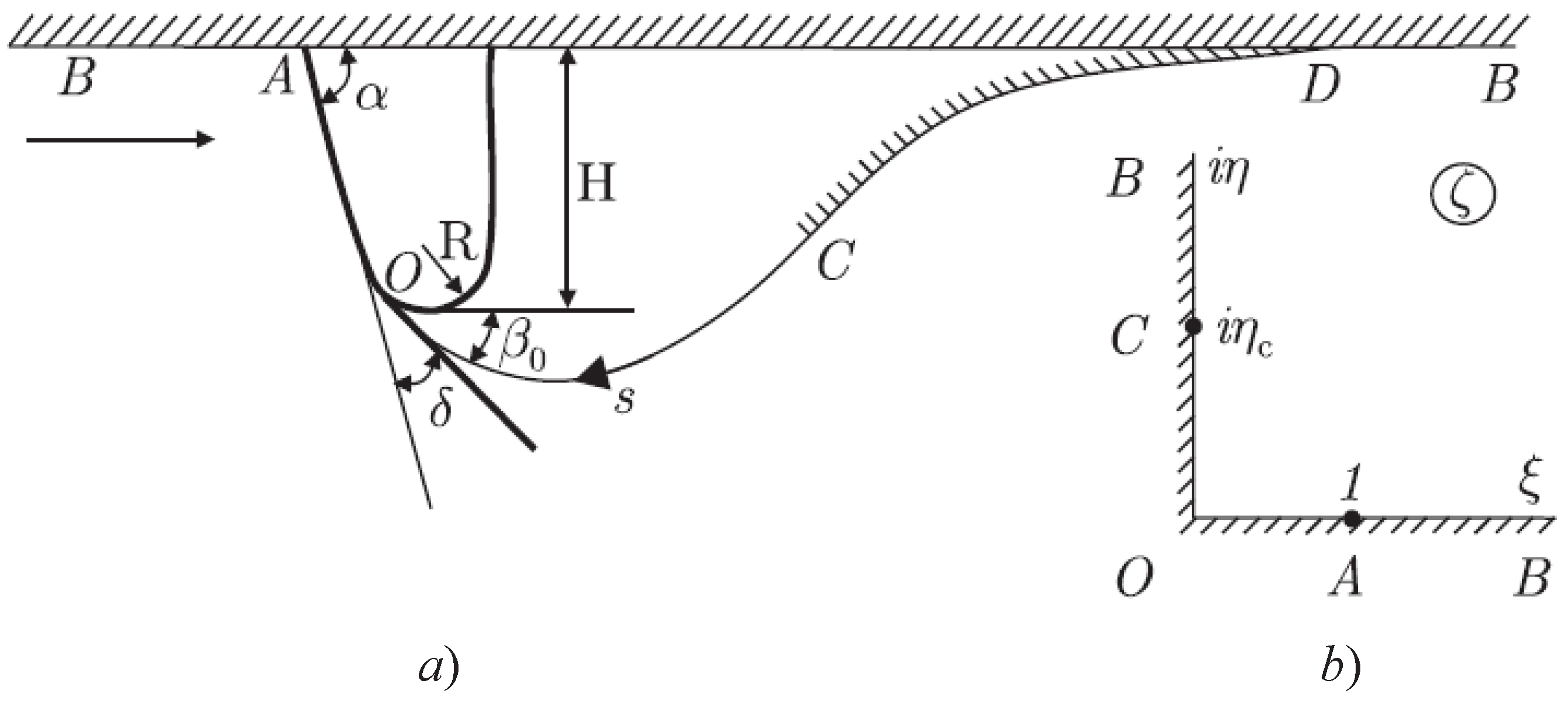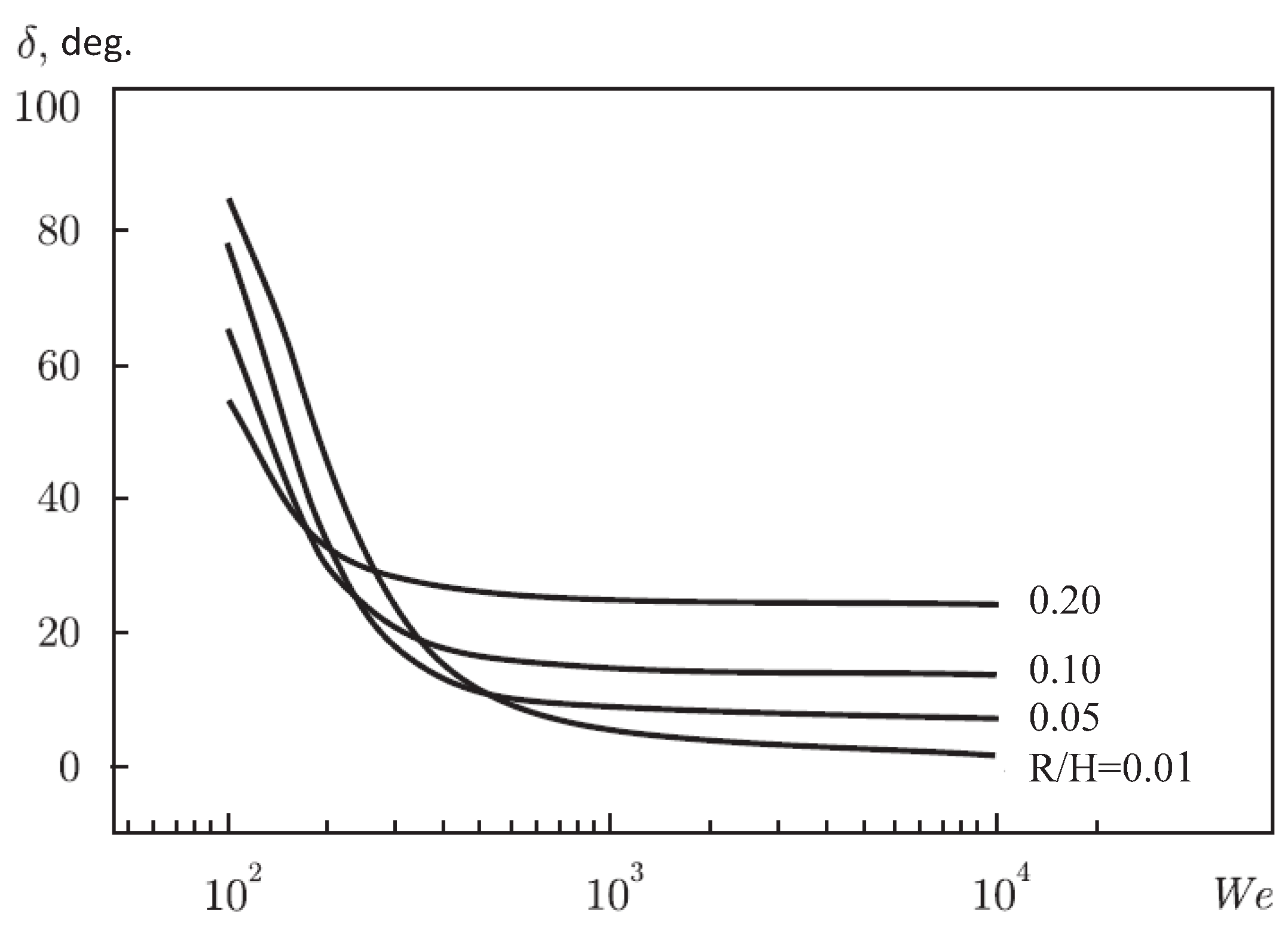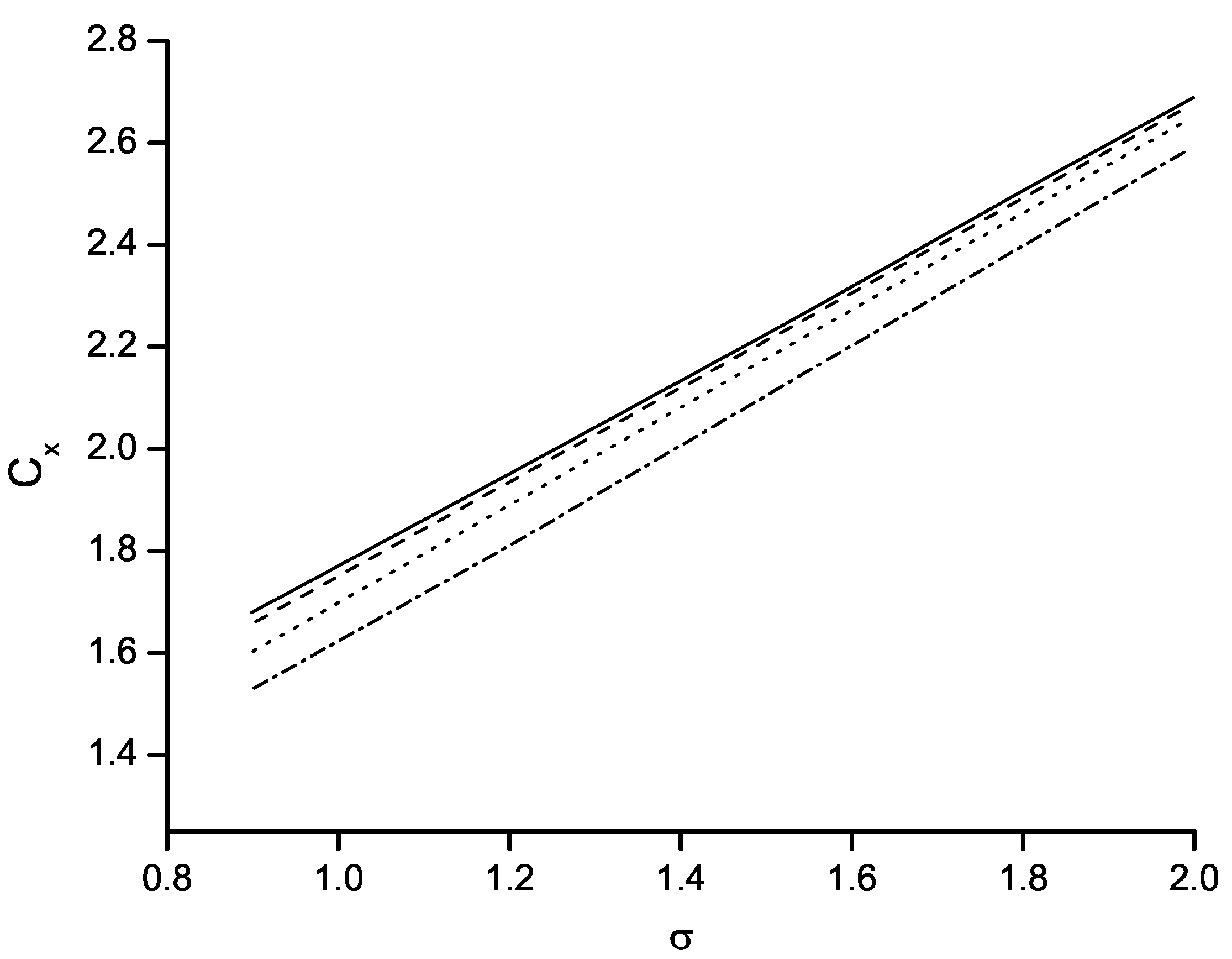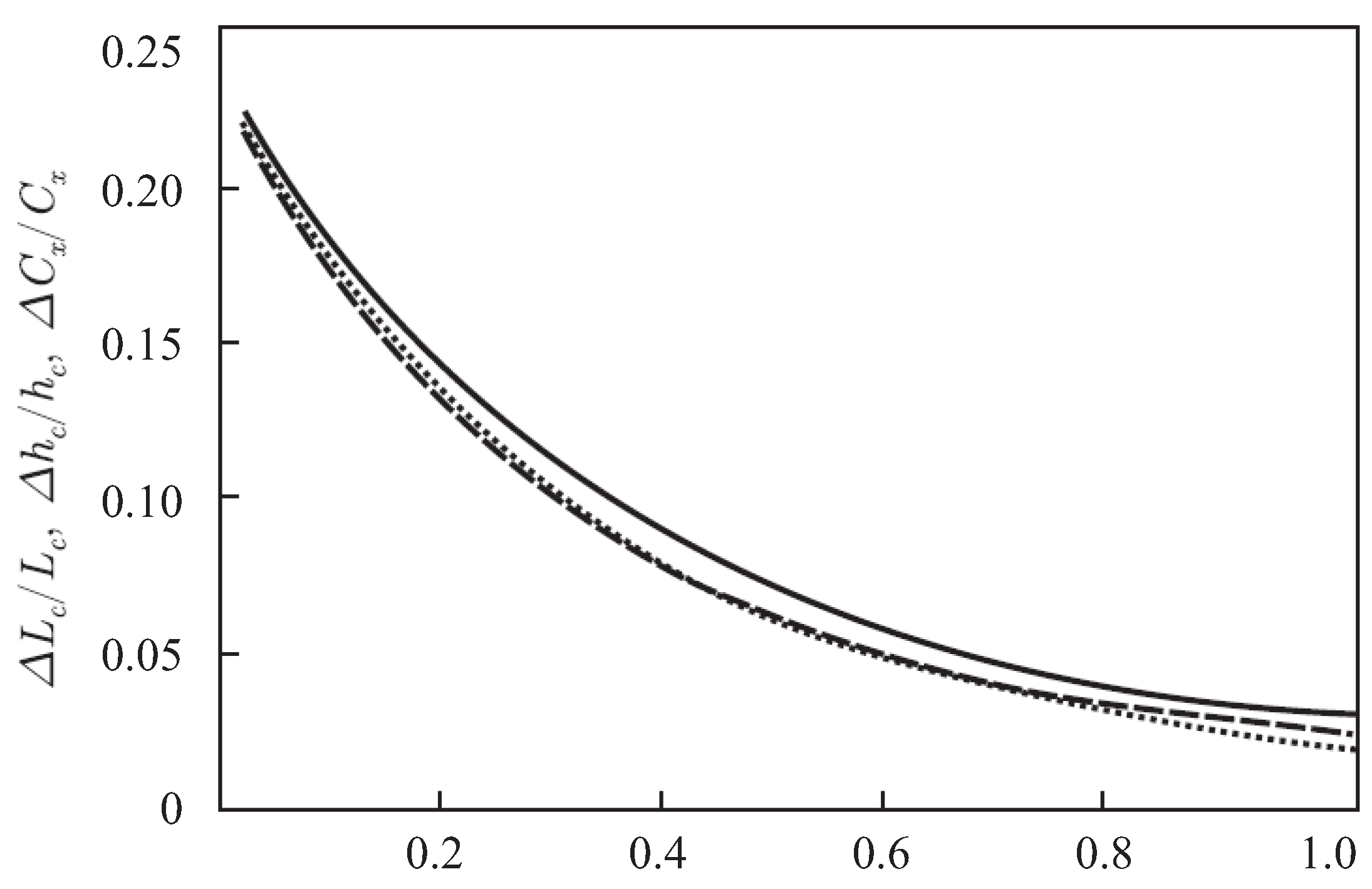1. Introduction
Surface tension arises at an air–liquid interface as a result of a reversible isothermokinetic process on a free boundary. According to the Young–Laplace equation, surface tension results in a pressure jump, which is governed by the curvature of the cavity boundary. The dynamic boundary condition in the model of the ideal fluid (Bernoulli equation) includes this jump; therefore, the velocity modulus on the cavity boundary, the pressure on the liquid side of the interface, and the curvature of the interface are related to one another. Cavity detachment for smooth-shaped bodies is determined by the Brillouin–Villat criterion [
1,
2], which states that the curvature of the cavity boundary should be equal to the curvature of the body at the point of detachment. This criterion comes from geometrical restrictions on the cavity curve and, therefore, it should be valid for flows both with and without surface tension. As the surface tension tends to zero, the solution of the problem gradually approaches its limiting case without surface tension, as shown in [
3], for cavity flow past a circular cylinder.
Cavity detachments for bodies whose shapes form corner trailing edges are different, and it is not fully understood yet when the surface tension is nonzero. Although the position of cavity detachment is predetermined at the edge, the curvature of the cavity boundary is infinite for the case of zero surface tension [
4,
5]. Even small surface tension might result in an infinite negative pressure at the cavity detachment point. The same infinite negative pressure occurs for flow around a corner without flow detachment. Therefore, flow detachment may not occur at all.
Attempts to take into account surface tension in problems of cavity flows were done in [
6,
7,
8,
9]. The case of small surface tension values was considered in [
8] using the method of matched asymptotic expansions. For this case, the curvature of the cavity boundary equals the curvature of the plate at the point of detachment. Such a formulation of the problem leads to waves on the free surface. It was shown in [
9] that these waves have no physical basis since they require an energy input from infinity. In [
6,
7], it is assumed that at the flow detachment point, the tangent to the flow boundary is a discontinuous function. According to the theory of jets of an ideal liquid [
4,
5], this assumption leads to zero velocity at the point, while the curvature of the cavity boundary remains undetermined. Alternative models of cavity detachment were proposed in the works [
10,
11]. These models account for the physical properties of the liquid/structure interaction [
12,
13]. The work [
10] considers cavity detachment as bubbles growing within the boundary layer starting from the stagnation point; the coalition and merging of the bubbles form a cavity. The work [
11] considers adhesion between the liquid and the material of the body, which determines the contact angle between the body and the free surface. However, these models are not used widely in practice since further experimental validation of these models is required.
The surface tension force becomes dominant on the scale of mechanical elements far below millimeters, which is the typical size of microelectromechanical systems (MEMS) and microfluidic systems [
14,
15]. The study of cavitation phenomena in such systems is of interest when developing micropumps, microvalves, microcoolers, etc., which are fabricated with a micro-orifice of a smaller diameter than the main microchannel. Cavitation in MEMS appears in the same way as cavitation in macroscale devices, when the local pressure drops below the vapor pressure. However, on microscale, the surface tension force dominates other forces and may affect flow characteristics, which may be treated as a scale effect [
16,
17].
In this paper, we consider classical two-dimensional potential free surface flow around a wedge with rounded edges and apply the Brillouin–Villat criterion to determine the cavity detachment for the case of nonzero surface tension. A sharp trailing edge is considered as the limiting case of a rounded edge when the radius of the edge tends to zero. An analytical solution to the problem is obtained using the integral hodograph method [
18]. The complex velocity and the derivative of the complex potential are derived analytically in a parameter plane. A function mapping the parameter plane onto the physical plane is also obtained. The method is based on the integral formula [
19], which gives a solution of a mixed boundary-value problem for a complex function (here, the complex velocity) defined in the first quadrant. The derivative of the complex potential is obtained by using Chaplygin’s singular point method [
5,
20].
The complex velocity includes the slope to the body and the velocity modulus along the cavity boundary, which are determined from a system of integral equations derived by using the dynamic and the kinematic boundary conditions. By using an analytical expression for the curvature of the free boundary, it is possible to directly apply the Brillouin–Villat condition and obtain an equation to determine the point of cavity detachment.
The results are presented over a wide range of Weber numbers and the radius of the wedge edges. It is shown that the effect of surface tension becomes more pronounced as the Weber number or the radius of the edge decrease. The surface tension results in some reduction of the cavity length and the drag force coefficient and delays cavity detachment. The point of detachment moves downward, increasing the wetted part of the rounded edge. It is found that, for each edge radius, there exists a critical Weber number below which a solution cannot be obtained due to the iteration process failing to converge. This critical Weber number increases as the radius of the edge decreases. As the edge radius tends to zero, the Weber number tends to infinity, or a steady cavity flow cannot be computed for any finite Weber number in the case of a sharp wedge edge. This shows some limitation of the model based only on the Brillouin–Villat criterion of detachment.
2. Complex Potential of the Flow
We consider cavity flow past a wedge of width
with rounded edges of radius
R sketched in
Figure 1a. The wedge angle
lies in the range
. For
, the wedge becomes a flat plate. We introduce Cartesian coordinates
. The origin is located at point
O. The liquid is inviscid and incompressible. The flow is symmetric about the
-axis, so we consider only half of the flow region. An assumption as to the cavity closure is necessary due to the Brillouin paradox at the point where the upper and the lower cavity boundaries are merged [
4]. We introduce an implicit model of cavity closure according to which, along the streamline
, the velocity modulus changes in such a manner that the portion
corresponds to the cavity boundary, and on the portion
the velocity modulus changes from the value
at the end of the cavity (point
C) to the value
U at point
D. The velocity
U is the velocity at infinity. Along the contour
, the velocity remains constant and equals
U. As
, the
-coordinate of the closing line
tends to zero. Such a cavity closure model mimics a turbulent wake in real cavity flows [
21,
22].
The pressure jump across the cavity boundary is determined by the Laplace–Young formula
where
is the coefficient of surface tension,
is the pressure in the cavity, and
is the curvature. The pressure in the cavity may be equal to the vapor pressure,
, or be higher for gaseous liquids.
We choose
H and
U as the characteristic length and velocity, respectively. From the equation
and Equation (
1) the velocity modulus on the cavity boundary is obtained
where
. Here,
is the Weber number that characterizes the ratio of the inertia force to the surface tension force, and
is the cavitation number indicating the degree of cavitation development.
where
is the density of the liquid, and
is the pressure at infinity.
We can introduce a complex potential,
, where
and
are the harmonic conjugate function of the potential and the stream function, respectively. The determination of the function
is a challenging problem. Instead, Michell [
23] and Joukovskii [
24] introduced an auxiliary
-plane and determined the complex conjugate velocity,
, and the derivative of the complex potential,
, as functions of the parameter variable
. If these functions are known, then the solution of the problem is obtained in parametric form:
where
is the value of the complex potential at point
O, and
is the coordinate of point
O.
We choose the first quadrant of the
-plane in
Figure 1b as the region corresponding to the liquid region in the physical plane (
Figure 1a). According to the conformal mapping theorem, we can chose the position of three points. They are points
O (
),
A (
), and
B (
), as shown in
Figure 1b. The interval
corresponds to the wetted part of the wedge, and the interval
corresponds to the symmetry line
. The imaginary
-axis corresponds to the boundary
, which includes the cavity contour
(
) and the closure contour
(
). The position of point
C (
) has to be determined from the solution of the problem and physical considerations. In order to determine these functions, we assume that the velocity modulus
v and the tangent to the wetted part of the body
are known functions of the variables
and
, respectively.
2.1. Expressions for the Complex Velocity and for the Derivative of the Complex Potential
The body is considered to be fixed; therefore, the velocity direction and the slope of the body coincide. Besides, at this stage we assume that the velocity magnitude on the free surface is a known function of the parameter variable,
. Then the boundary-value problem for the complex velocity in the first quadrant of the parameter plane can be written as follows
Here,
at point
O, and
as
. Equation (
6) satisfies the conditions:
along the interval
on the symmetry line and
along the body. The argument of the complex velocity exhibits a jump
at point
A when we move along the boundary in the physical plane from point
O to point
B. This boundary-value problem can be solved by applying the following integral formula [
19]:
where
and
. Substituting Equations (
6) and (
7) into (
8) and evaluating the first integral over the step change at the point
, we obtain
Here, we used
, which follows from the definition. It can be easily verified that for
the argument of the right-hand side of (
9) is the function
, while for
the modulus of (
9) is the function
, i.e., the boundary conditions (
6) and (
7) are satisfied. It can also be seen that the complex velocity function has zeros of order
, which correspond to flow around a corner of angle
at point
A.
The velocity is tangent to the boundary for steady flows and, therefore,
both along the body and along the cavity boundary. The real part of the complex potential increases from
at point
B to
at point
. Thus, the region of the complex potential is a half-plane. The first quadrant and the half-plane of the
-plane are related as
where
K is a positive real number. Then one can obtain
The derivative of the mapping function is obtained by dividing (
10) by (
9)
The integration of this equation yields the mapping function
relating the parameter and the physical planes. Equations (
9) and (
10) include the parameter
K, and the functions
and
, which are determined from the boundary conditions and from physical considerations.
The arc length coordinates along the body,
, and along the cavity boundary,
, are obtained as follows:
where
The real factor
K is determined from the condition for the length of the wetted part of the wedge, including the trailing edge
. By substituting Equation (
13) into (
12), we obtain
2.2. Cavity Closure Model
A solution of the problem of cavity flow around a body is not unique in the framework of the model of ideal liquid due to a paradox that arises at the point of cavity closure. On the one hand, the velocity at this point must be equal to the velocity on the cavity boundary since this point belongs to it. On the other hand, the velocity at this point should be equal to zero since the upper and the lower contours of the cavity merge into one streamline. This is known as the Brillouin paradox [
4].
Various assumptions as to the flow in the cavity closure region were proposed by Roshko, Riabouchinsky, Efros, in the re-entrant jet model, Tulin, etc., to resolve this paradox. They are now well known as classical models of cavity flows [
5]. These models give similar results for developed cavity flows, for which the size of the cavity is larger than the size of the body. However, when the cavity size is smaller, the cavity contour ends on the body surface (partial cavitation), and the assumptions made may affect the results [
10,
25].
An implicit cavity closure model modeling effects of the liquid viscosity in the cavity closure region was proposed in [
21,
22,
26]. It is based on dividing the flow region into viscous and inviscid subregions and the application of viscous/inviscid interaction conditions along the interface. In this work, we simplify the model by dropping the viscous wake and using an assumption as to the velocity distribution along the closing contour.
We assume that the velocity magnitude,
, linearly decreases from the value
at point
C determined by Equation (
3) to the value
U at point
D and then remains constant along
where
,
and
are the arc length coordinates of points
C and
D, respectively.
From the balance of the flow rate upstream and downstream, the
-coordinates of the boundary
at right infinity (point
B) should be equal to zero; that is
where
.
By using the theorem of residues, we evaluate the integral and get the following equation
This is an implicit equation in the cavity length,
. The magnitude of the velocity
,
, given by Equation (
15) and the cavity length
affect the second integral in Equation (
17). The unique value
, satisfies Equation (
17).
2.3. Brillouin–Villat Condition of Cavity Detachment
The Brillouin–Villat criterion [
1,
2] comes from the consideration of possible configurations of the cavity boundary near the detachment point. It states that the curvature of the cavity boundary at the point of cavity detachment should be finite and equal to the curvature of the body. This conclusion is based on the following considerations. In order to determine the curvature of the cavity boundary, we first find the slope of the cavity boundary by taking the argument of the complex velocity from Equation (
9)
Then, differentiating the above equation, we find the curvature of the free surface
At the detachment point
; therefore, the denominator of the above equation equals zero. The curvature may take a finite value if the nominator at
also equals zero, or
This is an equation in the unknown length of the wetted part of the body, , which affects the function , .
2.4. Integro-Differential Equations in the Functions and
The function
is known due to the given shape of the body. Then the function
is determined from the integro-differential equation
where
is the curvature of the body given as a function of the arc length
s.
In order to derive an integral equation in the function
, we substitute (
19) into the dynamic boundary condition (
3)
where
According to the Brillouin–Villat criterion, the curvature of the free surface at the cavity detachment point equals the curvature of the body, or
. Then, the velocity magnitude at the point of cavity detachment is obtained from Equation (
3)
From the above equation, it follows that the velocity magnitude at the cavity detachment point tends to infinity as the radius of the edge tends to zero or the Weber number tends to zero.
4. Conclusions
The effect of surface tension on cavity flow past a wedge with rounded edges was studied theoretically based on an analytical solution that satisfies the Brillouin–Villat criterion for cavity detachment. The integral hodograph method was employed to derive analytical expressions for the complex velocity potential of the flow, the complex velocity, and the mapping function in integral form. These expressions contain the velocity magnitude along the cavity boundary and the slope of the wetted part of the wedge, both as functions of a parameter variable. The solution is obtained in the form of a system of integral equations using the dynamic and kinematic boundary conditions.
A case study is presented for a flat plate with rounded edges. The solution made it possible to determine the range of applicability of the model, which depends on the radius of the edges and the Weber number. For moderate Weber numbers, the surface tension slightly decreases the size of the cavity and the drag force. As the Weber number decreases further, the velocity at the point of cavity detachment increases, and the angle of flow detachment changes in such a manner that the wetting part of the edge becomes larger. The tendency seems to be towards to wetting the whole of the edge and making the flow attached to the wedge. However, this situation is not observed in the results due to the iteration process failing to converge for Weber numbers below some critical value. In these cases, a steady flow solution cannot be obtained. A similar situation occurs when the wedge radius tends to zero at some fixed value of the Weber number. The results obtained suggest that at Weber numbers below the critical value, the flow may become unsteady, and the point of cavity detachment may oscillate about some position on the edge. To verify this mechanism of cavity detachment, an advanced formulation of the problem, including flow unsteadiness and a more sophisticated flow model, are needed.











